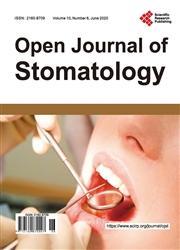Screening Survey of Pain Intensity in Patients with Temporomandibular Disorders
引用次数: 0
Abstract
Objective: Pain tends to be the chief complaint in patients suffering temporomandibular disorders (TMD). Previous studies on pain and psychosocial factors have reported on the relationship between presence of pain and mental disorders. To date, however, few studies have addressed the relationship between intensity of pain and psychosocial factors. In this study, we investigated the relationship between intensity of pain and age, gender, palpation scores (PPS), tendencies toward depression, anxiety, and somatization, and oral parafunctional habits. Methods: This screening survey encompassed 104 patients (70 women and 34 men; mean age of 46.1 ± 19.3) who visited our clinic. We gathered the following data: age; gender; PPS included in Axis I diagnosis; and characteristic pain intensity (CPI), depression, anxiety, somatization, and oral parafunctional habits (assessed by the Oral Behavior Checklist) included in Axis II diagnosis. Based on the results of CPI, we divided patients into two groups: those experiencing low pain intensity (LP group) and those experiencing high pain intensity (HP group). The statistically significant level was set to below 5%. IBM SPSS Statistics V25 was used to perform all statistical analyses. Results: We observed no gender differences between LP and HP groups. The HP group included significantly more patients with higher scores for depression, anxiety, somatization, and oral parafunctional habits than the LP group. While no gender differences were observed in CPI, depression, anxiety, somatization, and oral parafunctional habits were significantly more common in women than in men. We observed no differences in age or PPS between the LP and HP groups. However, scores for depression, anxiety, somatization, and oral parafunctional habits were significantly higher in the HP group than in the LP group. We performed multiple regression analysis using the CPI score as the dependent variable and scores for depression, anxiety, somatization, and oral parafunctional habits as independent variables in both the LP and the HP groups. We identified no significant predictors for the LP group, but extracted depression as a significant predictor in the HP group. On evaluating the correlation of PPS with depression, anxiety, somatization, and oral parafunctional habits in both the LP and the HP groups, we found no correlation between the PPS and the seven-item generalized anxiety disorder (GAD-7) scale in the LP group but identified a significant correlation between the PPS and GAD-7 scores in the HP group. Moreover, the correlation coefficient between the patient health questionnaire (PHQ)-9 and GAD-7 scores was higher in the HP group than in the LP group. Conclusion: In those reporting more intense pain, we found a stronger correlation among psychological factors in patients diagnosed with TMD. Greater tendency toward depression was directly associated with pain intensity. The results point to the need to consider differences in psychosocial factors associated with pain intensity when treating TMD.颞下颌疾患患者疼痛强度的筛查调查
目的:疼痛往往是颞下颌关节紊乱病(TMD)患者的主要主诉。先前关于疼痛和心理社会因素的研究已经报道了疼痛的存在与精神障碍之间的关系。然而,迄今为止,很少有研究涉及疼痛强度与心理社会因素之间的关系。在这项研究中,我们调查了疼痛强度与年龄、性别、触诊评分(PPS)、抑郁、焦虑和躯体化倾向以及口腔副功能习惯之间的关系。方法:这项筛查调查包括104名患者(70名女性和34名男性;平均年龄46.1±19.3),他们访问了我们的诊所。我们收集了以下数据:年龄;性别PPS纳入I轴诊断;以及Axis II诊断中包括的特征性疼痛强度(CPI)、抑郁、焦虑、躯体化和口腔多功能习惯(通过口腔行为检查表评估)。根据CPI的结果,我们将患者分为两组:经历低疼痛强度的患者(LP组)和经历高强度疼痛的患者(HP组)。统计显著水平被设定为低于5%。使用IBM SPSS Statistics V25进行所有统计分析。结果:LP组和HP组之间无性别差异。HP组包括的抑郁症、焦虑症、躯体化和口腔多功能习惯得分较高的患者明显多于LP组。虽然在CPI方面没有观察到性别差异,但抑郁、焦虑、躯体化和口腔多功能习惯在女性中明显比男性更常见。我们在LP和HP组之间没有观察到年龄或PPS的差异。然而,HP组的抑郁、焦虑、躯体化和口腔副功能习惯得分显著高于LP组。我们在LP组和HP组中使用CPI得分作为因变量,抑郁、焦虑、躯体化和口腔多功能习惯得分作为自变量进行了多元回归分析。我们没有发现LP组的显著预测因素,但提取抑郁症作为HP组的显著预测器。在评估LP组和HP组PPS与抑郁、焦虑、躯体化和口腔多功能习惯的相关性时,我们发现LP组的PPS与七项广泛性焦虑症(GAD-7)量表之间没有相关性,但HP组的PPS和GAD-7评分之间存在显著相关性。此外,HP组患者健康问卷(PHQ)-9和GAD-7评分之间的相关系数高于LP组。结论:在那些报告更剧烈疼痛的患者中,我们发现被诊断为TMD的患者的心理因素之间有更强的相关性。更大的抑郁倾向与疼痛强度直接相关。研究结果表明,在治疗TMD时,需要考虑与疼痛强度相关的心理社会因素的差异。
本文章由计算机程序翻译,如有差异,请以英文原文为准。
求助全文
约1分钟内获得全文
求助全文

 求助内容:
求助内容: 应助结果提醒方式:
应助结果提醒方式:


